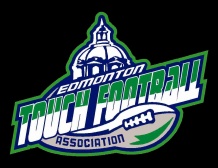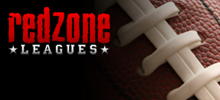Registration Process
Information will be available on the website once the registration dates and fees for 2010 have been determined.
Starting a Team
Before you decide to start a team in any organized sport you must understand that it is a year long responsibility. Running a team can be a very difficult and trying task, but with some help your team can operate smoothly and successfully which can be very rewarding.
Here are some tips that should help you start your own touch football team in the Edmonton Touch Football Association (EFTA):
- When approaching players, don't just go for the most talented players. They don't always show up to games, so look for the most committed players. Make sure your players are aware of the time commitment required during the summer months and also the time for practices. A good number to carry on your roster is about (10-13 players).
- Try to practice at least once per every couple of weeks during the season, and at least 5-7 times before the season starts.
- Make sure you register on time and that your registration forms are complete with postal codes.
- Collect at least enough money from each player to cover league fees as well as other expenses like footballs, jerseys, beer funds, etc. Although Jerseys are not compulsory in the EFTA it will make your team look more organized and help with Team Moral. Maybe $75 - 100 per player would be a good start. You could charge more for the cost of Jerseys.
- Try to find a sponsor (i.e.) sports pub you frequent or friends with a business to help with the team costs. Remind them that it is tax deductible. If you do receive sponsorship from a business, make sure you keep your end of the bargain by frequenting their establishment. Sports Pubs do talk to other sports pubs and if you burn one for a few hundred dollars, chances are they will put the word out on you.
- Share the team responsibilities amongst all the players. Appoint an equipment person, beer person, sponsorship rep, team manager, etc. Do not attempt to do it all yourself. If you do decide you would be the best to run your team and all of the categories that need your attention, keep financial records for you players to see.
- Get all your players a team phone list and schedule and stress upon them the importance of calling someone if they can't make a practice or game. You need 6 players to "Start" a game (if the opposing team agrees) in the EFTA, if your players don't show up because they were unaware of a league game time, it will cost you in points deducted from your standings and also money from your pocket in the forms of League fines.
- Come game day try to get everyone to the field at least 15 minutes to half an hour early to warm up.
- Coming early to the field and staying after games allows your team to bond while; enjoying other games, learning about other teams, learning the game better, and getting to meet other players. The best way to get a scouting report about another team is to take the time and watch them play. If you compete in a lower division the best way to get better is to learn from someone else, watch an elite game if you have the time.
- Keep informed about things going on in your league such as league meetings, tournaments, field conditions, etc. Keep every player informed. This website is the best place to receive information so view it often!
- Have fun and play hard and remember if you have any questions or concerns contact us.
Knowing the Game
While football is football wherever you go there are still things that are unique to touch football that we want to share with you and you should learn.
Offensive tips
Quite often the best teams have been successful by marching the ball down the field with short plays. Patience is a key. The long balls are nice, however, if a defense will give you 5-7 yards a play that's all it takes. Again, be patient and set up the long ball. The easiest ball to intercept is one that takes the longest to get to the Offensive Receiver, a Defender can make up to 10 yards in Distance while the ball is in the air to create an interception or knock it down.
If you have more than one player who can throw the ball well, you may want to try using them in the backfield. If you can disguise it by bringing the man in motion on the snap of the ball, quite often you will catch the defense off guard which can buy you a lot of time.
The rushers can be very quick and in the QB's face right away so to avoid any sacks you can take a deeper drop. If you are a slow footed QB get rid of the ball faster. If your QB is quick they can scramble around or run down the field for a first down, use your skills to the best of your abilities.
In touch football, like in the CFL, the official field size is 65 yards wide by 110 yards long. It is in your best interest to use the whole field. Spread the ball around. Throw the 10 yard outs to the sidelines, throw the ball deep down the middle, and of course short all over. If you just throw the ball to one side or just short in the middle a good defense will read this and eat you up.
Spread the receivers out, don't bunch up. The best way to stretch a defense vertically down field is to stretch them horizontally also. With the Wide Receivers out closer to the sidelines, it will help open up some lanes and create some cushions in the zones for your receivers to exploit.
With the end-zones sometimes only 10 yards deep it can be extremely difficult to score when inside the 20 yard line (aka, The Red Zone). As well, the extra points after a touchdown are tried from the 5 yard line (1 pt) or the 10 (2 pts). So at practices it is a good idea to work on your offenses inside 'The Red Zone'.
Defensive tips
The most common defense you will likely play will be the 4-2 zone defense. This is made up of 4 short-yard defenders (2 corners and 2 in the middle) and 2 long-yard defenders (safeties). Another common defense is a man to man defense. Everyone just takes a player. The rushers must be aware of scrambling QBs. Touch football is full of speedy QBs that unless contained, will pick apart any defense with the extra time they create by beating the rush.
Try to avoid showing your defense to your opponents before the ball is snapped. If you always line up 6 across the field then jump into your defense on the snap of the ball, it is a lot harder for a QB to read. Disguise it the best you can by creating switches at the snap of the ball where your inside guys switch and take their opposite players lined up below them. Make it difficult for the QB to make decisions.
Every defensive formation has weaknesses. Be aware of this and call your defense accordingly. Try to anticipate what the opposing QB is going to do every play.
Deep is deep. If you are playing deep coverage get good depth, don't let anyone behind you. Also if you are playing short coverage do not back up. You should always be jumping the short plays and knocking the ball away or picking it off. Remember, if you line up 5 - 7 yards off the ball and your first step is backwards to go into coverage, you just gave up 8 yards in the first second of play. Shorten it up and always place your best defenders on the field.
In man to man coverage stay with your man, don't get beat deep. If your opponent is too hard to cover, give them more room or trade off with a teammate.
Knowing Some Rules
Most of touch football's rules are the same as those found in the CFL, however, there are a number of distinct differences. Here are a few that you may encounter:
- The game is played with 7 players a side and each team must have at least 6 players to start the game (if the opposing team agrees). You can finish with less in the event of an injury or ejection.
- There are four 20 minute quarters per game.
- Each team gets one 1 minute time-out per half and an additional 1 minute time-out that may be used in either half but not both.
- All offensive players are eligible receivers.
- One handed touch anywhere will stop the play, however, head tags can draw up to a 15 yard penalty.
- There is absolutely no contact allowed at any time, anywhere. This means no blocking. A lot of inadvertent contact does occur which can sometimes draw penalties.
- You can not obstruct the rushers path to the QB. The rushers are afforded a straight path to the QB starting from 5 yards behind the scrimmage line.
- The QB must take at least a 5 yard drop when receiving the snap.
- Any movement by the offense prior to the snap is permitted as long as you stay on side.
- Backward laterals are permitted.
- There are no field goals tried. Extra points after a touchdown are tried from either the 5 yard line for 1 point or the 10 yard line for 2 points.
- At any time your offense can elect to punt the ball through the end-zone for 1 point.
- Again these are just some of the different rules you may encounter. To be best prepared for the season you should obtain a rule book and read through it.
We know that it can be hard breaking into any sports league as a new player so the Edmonton Touch Football Association is committed to placing you with a team that will match your skill and comfort level.
Additional Tips
- Familiarize yourself as best you can with the rules of the game.
- Learn as much as you can about offensive and defensive plays and strategies.
- Try to watch other games in the league so that you can meet other players and learn more about the game.
- Getting involved with the league is a sure way to enjoy the season more.
If you have any questions or concerns, let us know.



